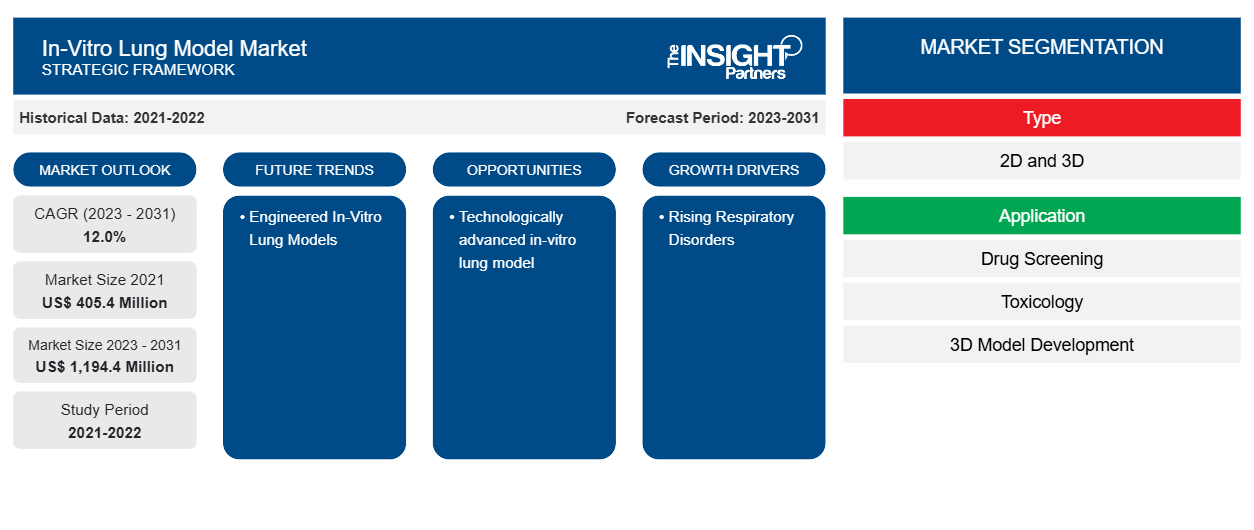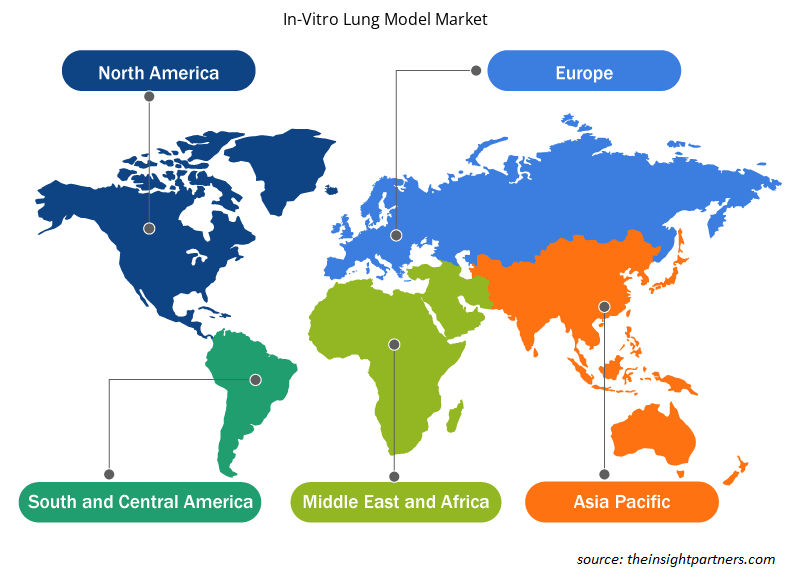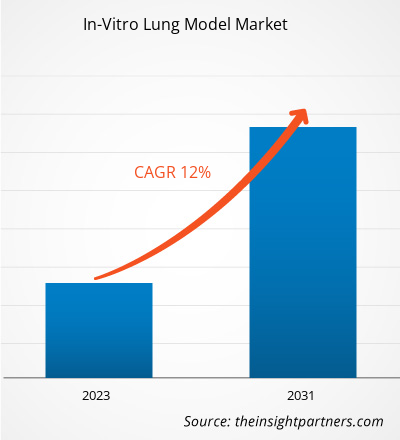Le marché des modèles pulmonaires in vitro devrait atteindre 1 530,11 millions de dollars américains d'ici 2031, contre 446,35 millions de dollars américains en 2024. Le marché devrait enregistrer un TCAC de 19,4 % entre 2025 et 2031. Les applications des cultures 3D et de l'IA en oncologie devraient apporter de nouvelles tendances au marché dans les années à venir.
Analyse du marché des modèles pulmonaires in vitro
La croissance du marché est stimulée par la prévalence croissante des maladies respiratoires et l'adoption croissante de modèles in vitro comme alternative aux tests sur les animaux. Les coupes pulmonaires de précision (PCLS) permettent d'étudier la constriction et l'inflammation des voies respiratoires, facilitant ainsi l'évaluation de nouvelles cibles thérapeutiques pour l'asthme et d'autres affections respiratoires. Des dispositifs « poumon sur puce » ont été développés pour reproduire les conditions physiologiques du poumon humain. Le dispositif « poumon sur puce » de l'Université du Michigan utilise des cellules pulmonaires humaines cultivées sur une puce en plastique dotée de canaux microscopiques pour simuler les conditions à l'intérieur des poumons, offrant ainsi de nouvelles perspectives sur les maladies. Ainsi, la demande croissante de traitements efficaces et de modèles de recherche alimente la croissance du marché des modèles pulmonaires in vitro.
Aperçu du marché des modèles pulmonaires in vitro
Selon les données des Centres pour le contrôle et la prévention des maladies (CDC), l'asthme a touché environ 25 millions de personnes aux États-Unis en 2021. Selon l'OMS, en 2022, environ 2,5 millions de personnes ont reçu un diagnostic de cancer du poumon et plus de 1,8 million de personnes sont décédées des suites de la maladie. Selon les données de l'OMS, entre l'apparition de la COVID-19 fin 2019 et avril 2023, le nombre de cas signalés s'élevait à environ 762 millions, avec 6,81 millions de décès associés. Cette incidence croissante des maladies respiratoires stimule la demande de modèles de recherche avancés pour comprendre les mécanismes de la maladie et développer des traitements efficaces. Les modèles pulmonaires in vitro offrent des plateformes précieuses pour étudier les mécanismes de la maladie et tester des thérapies potentielles, contribuant ainsi au développement de traitements efficaces.
Vous bénéficierez d'une personnalisation gratuite de n'importe quel rapport, y compris des parties de ce rapport, ou d'une analyse au niveau des pays, d'un pack de données Excel, ainsi que de superbes offres et réductions pour les start-ups et les universités.
Marché des modèles pulmonaires in vitro : perspectives stratégiques

- Obtenez les principales tendances clés du marché de ce rapport.Cet échantillon GRATUIT comprendra une analyse de données, allant des tendances du marché aux estimations et prévisions.
Moteurs et opportunités du marché des modèles pulmonaires in vitro
Adoption croissante des modèles in vitro comme alternative aux tests sur les animaux
Les modèles pulmonaires in vitro offrent une alternative aux tests sur les animaux, permettant aux chercheurs d'étudier la biologie et les maladies pulmonaires humaines avec plus de précision et de pertinence. Ces modèles in vitro reproduisent fidèlement les alvéoles, les voies respiratoires, le système vasculaire, le mésothélium et l'interstitium du tissu pulmonaire natif. Leur composition multicellulaire permet une simulation précise de la dynamique spatiale et fonctionnelle des poumons in situ, ce qui en fait un outil indispensable en recherche biomédicale . Par conséquent, les chercheurs adoptent désormais les modèles pulmonaires pour un large éventail d'applications, de la modélisation des maladies à la toxicologie et au développement de médicaments. La bourse d'innovation 2021 a stimulé le développement d'un modèle pulmonaire synthétique à l'Université de Reading. Le lauréat, le Dr Hisham Al-Obaidi, et son équipe de l'Université de Reading ont reçu une bourse d'innovation de 8 692,19 $ US (6 500 £) en 2021 pour développer un modèle pulmonaire synthétique destiné à remplacer les tests sur les animaux. Le projet vise à créer un modèle pulmonaire in vitro pour évaluer l'efficacité des agents antimicrobiens. L'objectif est de fournir un modèle in vitro similaire aux poumons humains, contrairement aux méthodes traditionnelles basées sur les animaux. L'équipe a opté pour un modèle non biologique conçu pour simuler le comportement du médicament dans le système respiratoire humain. Son approche a démontré que le médicament testé pouvait pénétrer profondément dans la structure pulmonaire, traverser une couche d'hydrogel simulant le mucus et éliminer la présence bactérienne. L'équipe valide actuellement le modèle. Ce processus comprend des tests de l'impact de particules d'antibiotiques inhalées sur des colonies bactériennes matures cultivées sur des plaques de gélose afin de déterminer la présence de bactéries viables après le traitement. Ce modèle pourrait constituer un outil précieux pour prédire l'efficacité des antimicrobiens chez l'homme tout en réduisant le recours aux tests sur les animaux.
Augmentation du financement et des investissements pour les modèles in vitro
Les modèles pulmonaires in vitro offrent des simulations plus précises de la physiologie pulmonaire humaine que les cultures 2D traditionnelles. Cette avancée a attiré des investissements des secteurs public et privé. Emulate, société de biotechnologie spécialisée dans la technologie des organes sur puce, a attiré des investisseurs pour commercialiser des modèles à base de cellules humaines reproduisant les fonctions des organes. En septembre 2021, Emulate a levé 82 millions de dollars américains lors d'un tour de table de série E mené par le Founders Fund, soulignant la confiance dans les plateformes d'organes sur puce pour les tests de médicaments et la modélisation des maladies. En décembre 2024, Newcells Biotech, start-up biotechnologique britannique spécialisée dans le développement de modèles in vitro avancés pour la découverte de médicaments, a obtenu un financement de 1,60 million de dollars américains (1,2 million de livres sterling) auprès de Mercia Ventures, Northstar Ventures et North East Finance. Fondée en 2015 en tant que spin-off de l'Université de Newcastle, Newcells développe des modèles tissulaires 3D reproduisant la rétine, le rein et le poumon. Ces modèles permettent de prédire l'innocuité et l'efficacité des médicaments. Ce financement permettra à Newcells d'élargir sa clientèle, de nouer de nouveaux partenariats et d'améliorer son offre sur les principaux marchés internationaux. Ainsi, ces financements et investissements facilitent le développement de traitements plus efficaces contre les maladies respiratoires, offrant ainsi des perspectives d'avenir prometteuses aux entreprises des secteurs de la santé et des biotechnologies.
Analyse de segmentation du rapport sur le marché des modèles pulmonaires in vitro
Les segments clés qui ont contribué à la dérivation de l’ analyse du marché des modèles pulmonaires in vitro sont la technologie, le type d’animal, la voie d’administration, l’utilisateur final et la géographie.
- Selon le type, le marché des modèles pulmonaires in vitro se divise en modèles 3D et modèles 2D. Le modèle 3D détenait la plus grande part du marché des modèles pulmonaires in vitro en 2024 et devrait enregistrer un TCAC significatif entre 2025 et 2031.
- Par application, le marché est classé en deux catégories : découverte de médicaments et études toxicologiques, recherche physiologique, médecine régénérative , etc. En 2024, ce segment détenait la plus grande part du marché des modèles pulmonaires in vitro.
- En termes d'utilisateurs finaux, le marché des modèles pulmonaires in vitro est segmenté entre les sociétés pharmaceutiques et biotechnologiques, les instituts universitaires et de recherche, et autres. En 2024, le segment des sociétés pharmaceutiques et biotechnologiques détenait la plus grande part du marché des modèles pulmonaires in vitro, et il devrait enregistrer un TCAC significatif entre 2025 et 2031.
Analyse des parts de marché des modèles pulmonaires in vitro par zone géographique
La portée géographique du rapport sur le marché des modèles pulmonaires in vitro est principalement divisée en cinq grandes régions : Amérique du Nord, Europe, Asie-Pacifique, Moyen-Orient et Afrique, et Amérique du Sud et centrale. L'Amérique du Nord a dominé le marché en 2024. Les innovations technologiques et la solide infrastructure de recherche biomédicale contribuent à la croissance du marché nord-américain. Les innovations technologiques ont joué un rôle essentiel dans l'amélioration de la complexité et de la fonctionnalité des modèles in vitro. Les progrès de l'ingénierie tissulaire, de la microfluidique et des technologies d'organes sur puce ont permis le développement de modèles plus précis et prédictifs pour la découverte de médicaments et les études toxicologiques. Ces innovations facilitent la création de modèles reproduisant fidèlement la physiologie pulmonaire humaine, améliorant ainsi la fiabilité des tests précliniques et réduisant le recours aux expérimentations animales.
La région abrite des institutions universitaires, des organismes de recherche et des sociétés pharmaceutiques de premier plan, à la pointe de la recherche en modélisation pulmonaire in vitro. Ces institutions ont accès à des installations de pointe, à des technologies de pointe et à des chercheurs qualifiés, ce qui leur permet d'innover et de faire progresser ce domaine. La croissance du marché est également alimentée par la présence d'acteurs majeurs du secteur, le développement des programmes et réglementations en matière de bien-être animal, et une infrastructure de santé solide. De plus, des initiatives gouvernementales favorables et un nombre croissant de collaborations de recherche stimulent la croissance du marché des modèles pulmonaires in vitro.
Aperçu régional du marché des modèles pulmonaires in vitro
Les tendances et facteurs régionaux influençant le marché des modèles pulmonaires in vitro tout au long de la période de prévision ont été analysés en détail par les analystes d'Insight Partners. Cette section aborde également les segments et la géographie du marché des modèles pulmonaires in vitro en Amérique du Nord, en Europe, en Asie-Pacifique, au Moyen-Orient et en Afrique, ainsi qu'en Amérique du Sud et en Amérique centrale.

- Obtenez les données régionales spécifiques au marché des modèles pulmonaires in vitro
Portée du rapport sur le marché des modèles pulmonaires in vitro
| Attribut de rapport | Détails |
|---|---|
| Taille du marché en 2024 | 446,35 millions de dollars américains |
| Taille du marché d'ici 2031 | 1 530,11 millions de dollars américains |
| TCAC mondial (2025 - 2031) | 19,4% |
| Données historiques | 2021-2023 |
| Période de prévision | 2025-2031 |
| Segments couverts | Par type
|
| Régions et pays couverts | Amérique du Nord
|
| Leaders du marché et profils d'entreprises clés |
|
Densité des acteurs du marché des modèles pulmonaires in vitro : comprendre son impact sur la dynamique des entreprises
Le marché des modèles pulmonaires in vitro connaît une croissance rapide, portée par une demande croissante des utilisateurs finaux, due à des facteurs tels que l'évolution des préférences des consommateurs, les avancées technologiques et une meilleure connaissance des avantages du produit. Face à cette demande croissante, les entreprises élargissent leur offre, innovent pour répondre aux besoins des consommateurs et capitalisent sur les nouvelles tendances, ce qui alimente la croissance du marché.
La densité des acteurs du marché désigne la répartition des entreprises opérant sur un marché ou un secteur particulier. Elle indique le nombre de concurrents (acteurs) présents sur un marché donné par rapport à sa taille ou à sa valeur marchande totale.
Les principales entreprises opérant sur le marché des modèles pulmonaires in vitro sont :
- MatTek Corp
- Lonza Group AG
- Emulate, Inc
- CN Bio Innovations Ltd
- PromoCell GmbH
- Charles River Laboratories International Inc
Avertissement : Les entreprises répertoriées ci-dessus ne sont pas classées dans un ordre particulier.

- Obtenez un aperçu des principaux acteurs du marché des modèles pulmonaires in vitro
Actualités et développements récents du marché des modèles pulmonaires in vitro
Le marché des modèles pulmonaires in vitro est évalué en recueillant des données qualitatives et quantitatives issues de recherches primaires et secondaires, incluant des publications d'entreprises importantes, des données d'associations et des bases de données. Les principales évolutions du marché sont présentées ci-dessous :
- Emulate, Inc., fournisseur de modèles in vitro de nouvelle génération, a salué le plan récemment annoncé par la Food and Drug Administration (FDA) des États-Unis visant à réduire le recours aux tests sur les animaux dans les études de sécurité précliniques. La feuille de route stratégique de la FDA décrit comment les nouvelles approches méthodologiques (NAM), notamment les puces d'organes, la modélisation informatique avancée et d'autres tests in vitro, contribueront à optimiser le développement des médicaments, à réduire les coûts et à améliorer la sécurité des patients. (Source : Emulate Inc., site web de l'entreprise, avril 2025)
- Lonza, partenaire mondial de fabrication des marchés pharmaceutique, biotechnologique et nutraceutique, a annoncé aujourd'hui avoir signé un accord pour acquérir le site de fabrication de produits biologiques à grande échelle de Genentech à Vacaville, en Californie (États-Unis) auprès de Roche pour 1,2 milliard de dollars américains. (Source : Lonza, site Web de l'entreprise, mars 2025).
Rapport sur le marché des modèles pulmonaires in vitro : couverture et livrables
Le rapport « Taille et prévisions du marché des modèles pulmonaires in vitro (2021-2031) » fournit une analyse détaillée du marché couvrant les domaines suivants :
- Taille et prévisions du marché des modèles pulmonaires in vitro aux niveaux mondial, régional et national pour tous les segments de marché clés couverts par le champ d'application
- Tendances du marché des modèles pulmonaires in vitro, ainsi que la dynamique du marché, telles que les moteurs, les contraintes et les opportunités clés
- Analyse PEST et SWOT détaillée
- Analyse du marché des modèles pulmonaires in vitro couvrant les principales tendances du marché, le cadre mondial et régional, les principaux acteurs, les réglementations et les développements récents du marché
- Analyse du paysage industriel et de la concurrence couvrant la concentration du marché, l'analyse de la carte thermique, les principaux acteurs et les développements récents pour le marché des modèles pulmonaires in vitro
- Profils d'entreprise détaillés
- Analyse historique (2 ans), année de base, prévision (7 ans) avec TCAC
- Analyse PEST et SWOT
- Taille du marché Valeur / Volume - Mondial, Régional, Pays
- Industrie et paysage concurrentiel
- Ensemble de données Excel
Rapports récents
Témoignages
Raison d'acheter
- Prise de décision éclairée
- Compréhension de la dynamique du marché
- Analyse concurrentielle
- Connaissances clients
- Prévisions de marché
- Atténuation des risques
- Planification stratégique
- Justification des investissements
- Identification des marchés émergents
- Amélioration des stratégies marketing
- Amélioration de l'efficacité opérationnelle
- Alignement sur les tendances réglementaires




















 Obtenez un échantillon gratuit pour - Marché des modèles pulmonaires in vitro
Obtenez un échantillon gratuit pour - Marché des modèles pulmonaires in vitro